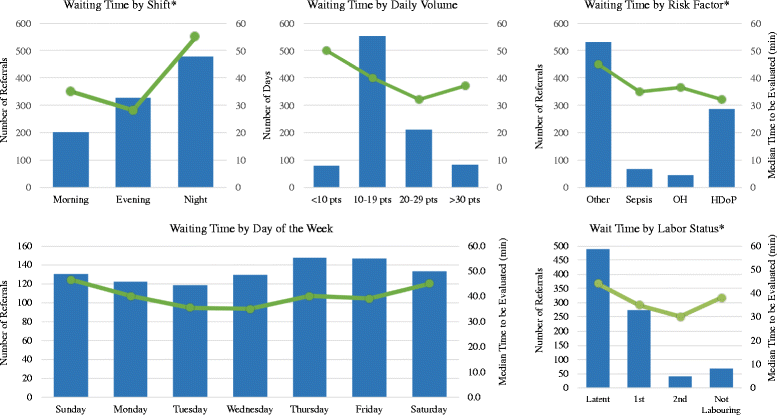The third delay: understanding waiting time for obstetric referrals at a large regional hospital in Ghana
- PMID: 28693518
- PMCID: PMC5504760
- DOI: 10.1186/s12884-017-1407-4
The third delay: understanding waiting time for obstetric referrals at a large regional hospital in Ghana
Abstract
Background: Delay in receiving care significantly contributes to maternal morbidity and mortality. Much has been studied about reducing delays prior to arrival to referral facilities, but the delays incurred upon arrival to the hospital have not been described in many low- and middle-income countries.
Methods: We report on the obstetric referral process at Ridge Regional Hospital, Accra, Ghana, the largest referral hospital in the Ghana Health System. This study uses data from a prospectively-collected cohort of 1082 women presenting with pregnancy complications over a 10-week period. To characterize which factors lead to delays in receiving care, we analyzed wait times based on reason for referral, time and day of arrival, and concurrent volume of patients in the triage area.
Results: The findings show that 108 facilities refer patients to Ridge Regional Hospital, and 52 facilities account for 90.5% of all transfers. The most common reason for referral was fetal-pelvic size disproportion (24.3%) followed by hypertensive disorders of pregnancy (9.8%) and prior uterine scar (9.1%). The median arrival-to-evaluation (wait) time was 40 min (IQR 15-100); 206 (22%) of women were evaluated within 10 min of arrival. Factors associated with longer wait times include presenting during the night shift, being in latent labour, and having a non-time-sensitive risk factor. The median time to be evaluated was 32 min (12-80) for women with hypertensive disorders of pregnancy and 37 min (10-66) for women with obstetric hemorrhage. In addition, the wait time for women in the second stage of labour was 30 min (12-79).
Conclusions: Reducing delay upon arrival is imperative to improve the care at high-volume comprehensive emergency obstetric centers. Although women with time-sensitive risk factors such as hypertension, bleeding, fever, and second stage of labour were seen more quickly than the baseline population, all groups failed to be evaluated within the international standard of 10 min. This study emphasizes the need to improve hospital systems so that space and personnel are available to access high-risk pregnancy transfers rapidly.
Keywords: Ghana; Low-middle income countries; Obstetric referral; Obstetric triage; Ridge regional hospital.
Conflict of interest statement
Ethics approval and consent to participate
The study was granted Institutional Review Board approval by Wake Forest University Health Sciences, Winston-Salem, North Carolina (IRB#00021947) and the Ghana Health Service, Accra, Ghana IRB#GHS/DGS/G-27) The study qualified for expedited review and met the criteria to waive informed consent.
Consent for publication
Not applicable.
Competing interests
The authors declare that they have no competing interests.
Publisher’s Note
Springer Nature remains neutral with regard to jurisdictional claims in published maps and institutional affiliations.
Figures
References
-
- Sustainable Development Goals: Goal 3, Ensure healthy lives and promote well-being for all at all ages. United Nations: Department of Economic and Social Affairs, Sustainable Development: Knowledge Platform. Available at: https://sustainabledevelopment.un.org/sdg3. Accessed 3 Aug 2016.
-
- Althabe F, Bergel E, Cafferata ML, Gibbons L, Ciapponi A, Alemán A, Colantonio L, Palacios AR. Strategies for improving the quality of health care in maternal and child health in low- and middle-income countries: an overview of systematic reviews. Paediatr Perinat Epidemiol. 2008;22(Suppl 1):42–60. doi: 10.1111/j.1365-3016.2007.00912.x. - DOI - PubMed
MeSH terms
LinkOut - more resources
Full Text Sources
Other Literature Sources
Medical


